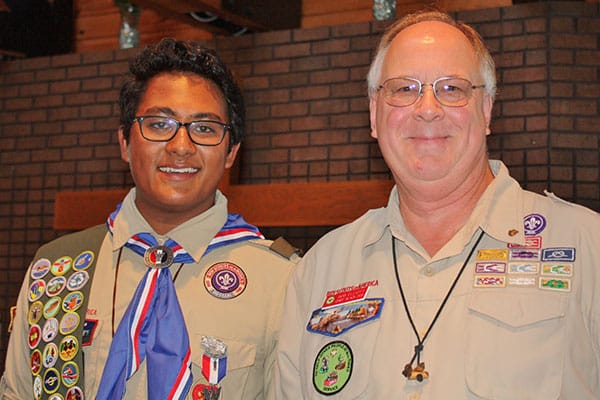Woodbury Scout Earns Rare Hornaday Award
An Award for Conservation
 On August 28, 2016, Akul Seshadri of Woodbury Boy Scout Troop 60 was awarded the rank of Eagle Scout and the rarely achieved Hornaday Badge for environmental conservation.
On August 28, 2016, Akul Seshadri of Woodbury Boy Scout Troop 60 was awarded the rank of Eagle Scout and the rarely achieved Hornaday Badge for environmental conservation.
According to Troop 60’s Scoutmaster, Mike Bradley, “The Hornaday Badge is a very rare achievement in the Boy Scouts. It takes an incredible amount of work. To give you some perspective, in 2015 there were 54,366 Eagles nationally, but nationwide less than 100 Hornaday Badges were awarded. In the Northern Star Council there were just under 800 Eagle Scouts in 2015, but there were only 2 Hornaday Badges. We are very proud of Akul’s achievement.”
Picking Akul
According to Robert Elliott, a member of Northern Star Council’s Conservation Committee who presented the Hornaday Badge to Akul, “So far in 2016, in our Council, only two Hornaday Badges have been awarded; a third is pending approval at National. The Hornaday Badge is so rare because a Scout is required to earn several conservation merit badges that aren’t required for Eagle, and because his Eagle project must be a conservation project that fits within one of 8 categories. Akul completed a significant erosion control project at the historic Dakota Indian holy place at Oheyawahi (Pilot Knob Hill) in Mendota Heights.”
Akul, in describing his project, said “41 volunteers contributed 438 combined hours to build nine gravel waterbars/gravel berms and two open-top culverts, fill in the existing erosion damage with gravel, and clear out overgrown vegetation to make drainage paths for runoff water to flow to the sides and not erode the trail. A gravel waterbar is a “speed bump of gravel” that crosses the trail diagonally to divert water into the surrounding terrain; an open top culvert is a wooden trench embedded in the ground to help divert water off of the trail.”
Mr. Elliott said “In order for Akul’s Eagle project to count as a Hornaday project, it included several aspects that aren’t required for an Eagle project.
- Akul researched why erosion happens, and the many possible methods of controlling erosion; then he chose a control method with a high likelihood of success which was within the beneficiary’s budget.
- He used that information to educate his helpers, other members of the troop, and the public about erosion control, which he did with displays and a YouTube video.
- He made two inspection trips to Pilot Knob Hill several months after the project was performed, to make sure the project did in fact reduce new erosion from happening. There has been no sign of new erosion since his project was performed a year ago. Then he met with the beneficiary to create a long-term follow-up plan to maintain the gravel berms and water bars installed during his project.”
